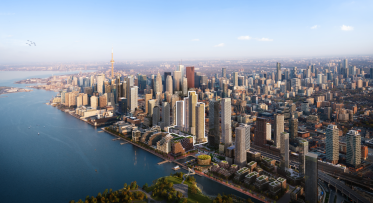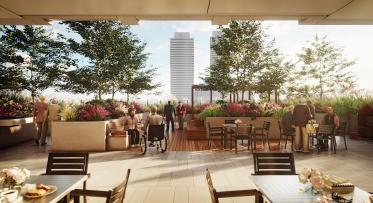Climate Leadership at Quayside
POSTED: APRIL 24, 2023
BY: COREY BIALEK, SENIOR ANALYST, INNOVATION & SUSTAINABILITY
In This Blog:
-
What better time than Earth Month to talk about climate leadership and how the approach to Quayside responds to our ambitious Green Building Requirements (GBRs).
-
Waterfront Toronto’s GBRs comprise a collection of performance measures designed to ensure that resilience and sustainability are sewed into every community from the start.
-
Once built, Quayside will be the largest zero-carbon, all electric development in Canada; it will include a variety of sustainability innovations like reducing upfront, or embodied, carbon emissions through using more sustainable building materials.
-
Quayside will be a resilient community focused on ecology; thriving in response to social and economic challenges; offering new public spaces; reducing waste and water use; and applying Indigenous values, knowledge and experience through meaningful collaboration.
-
The lessons learned throughout the Quayside project will be instrumental to guiding the design and buildout of future waterfront communities like Villiers Island.
The future of Toronto’s eastern waterfront is crystallizing as plans for the Quayside community come into focus. Quayside is a response to the challenge of how to build a dynamic, inclusive and resilient community for people of all ages, backgrounds, abilities and incomes. Together, Waterfront Toronto and Quayside Impact (the development team overseeing the build-out of the community) are planning a multifaced response that embraces five core impact areas: complete communities, equity and inclusion, public spaces, placemaking, and sustainability and resilience.
In this blog we take a closer look at the sustainable and resilient impacts of this forward-looking new community. After all, what better time than Earth Month to talk about climate leadership and how our development partners’ approach to Quayside responds to our Green Building Requirements and Resilience & Innovation Framework.
Resilience as a Key Value
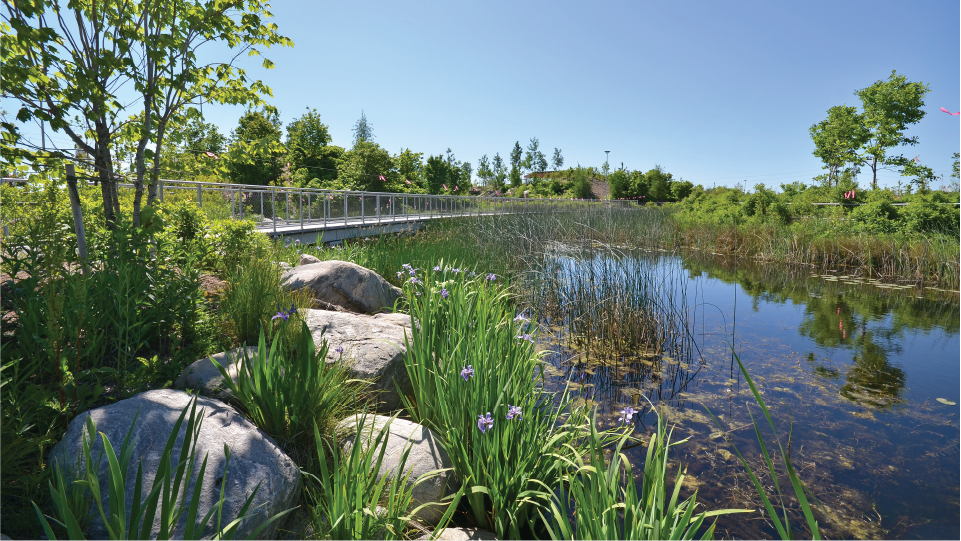
In Corktown Common, one of Waterfront Toronto’s signature parks, the large marsh is an integral part of the onsite stormwater management system and is home to birds, insects, frogs and ducks.
When we reached out to the public to hear what they wanted to see at Quayside, sustainability and resilience came up repeatedly. A resilient community is one that demonstrates climate leadership by reducing greenhouse gas emissions and managing the effects of extreme weather events. By using more sustainable materials and technologies, promoting biodiversity, and creating comfortable and accessible green spaces for all seasons and types of weather, resilient communities are built with sustainability as a first principle. This is the ethos that underwrites our Green Building Requirements (GBRs).
Version 3 of Waterfront Toronto’s GBRs comprises a collection of performance measures designed to ensure that resilience and sustainability are sewed into every community at the outset (read more about the Green Building Requirements here). In fact, adherence to the GBRs was a central pillar of the Quayside Request for Proposals, the competitive call for a development partner that established the expectations for this community. Quayside Impact (comprising local developers Dream Unlimited and Great Gulf Group) responded to our call to action with an ambitious proposal. That proposal, as described in the remainder of this blog, is now going through a detailed and iterative planning process where the preliminary designs and strategies are being tested and refined.
Canada’s Largest Zero-Carbon Development
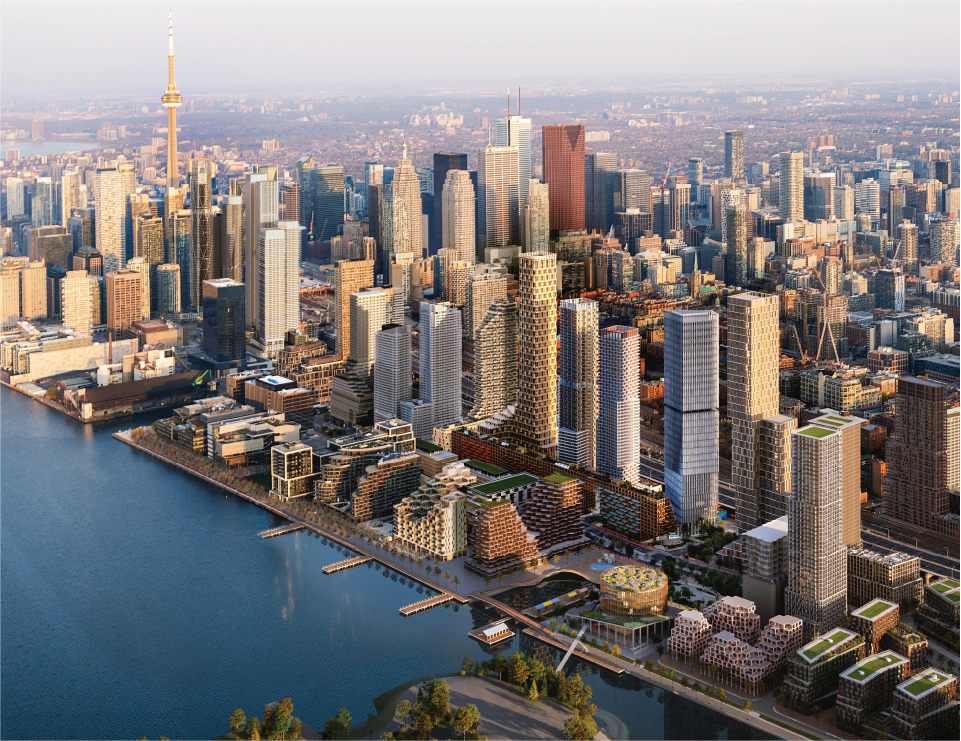
At about 3.4 million square feet, Quayside will be Canada’s largest all-electric, zero-carbon master planned community.
Once built, Quayside will be the largest zero-carbon, all electric development in Canada. It will include a variety of sustainability innovations, including a ground source heat pump system, which is an all-electric system that will leverage the bedrock below the site to store and supply thermal energy for buildings (both heating and cooling). The ground source heat pump system will reduce carbon emissions from heating.
Quayside Impact is also committed to meeting its carbon goals in accordance with the Canada Green Building Council (CaGBC) Zero Carbon Building Standards. What is a zero-carbon building? According to the CaBGC, “a zero carbon building is highly energy-efficient and minimizes greenhouse gas emissions from building materials and operations.” This ambition will be supported by using a suite of building design and technology solutions. While still early in the design process, it is expected that the buildings will be designed with low-carbon building materials, high-performing envelopes and solutions may also include renewable energy technologies like solar photovoltaics. We will continue to report on this aspect of the project as designs evolve.
More Than Operational Emissions: Reducing the Project’s Embodied Carbon
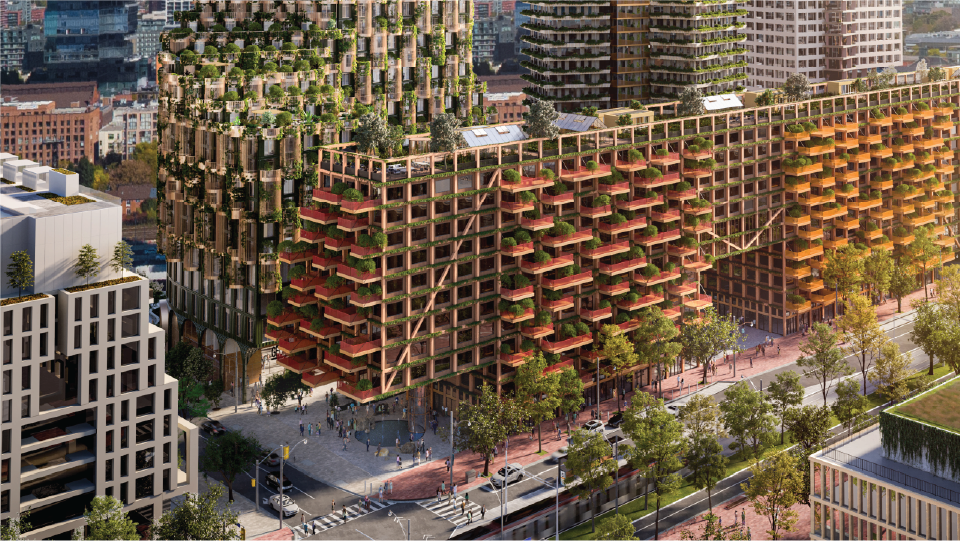
Timber House, designed by Adjaye Associates, will be one of Canada’s largest residential mass timber buildings when completed.
The GBRs also include requirements related to upfront, or embodied, carbon emissions. Embodied carbon is emitted through the manufacturing, installation, maintenance, and disposal of building materials and represents approximately 11% of a building's emissions. To put it into perspective, real estate development across the globe creates more than 3.7 billion metric tons of embodied carbon emissions annually, the equivalent of the annual emissions from 950 coal-fired power plants.
In response to the GBRs, Quayside Impact has committed to using more sustainable building materials to reduce the project’s embodied carbon emissions. For instance, the Timber House, designed by Adjaye Associates, will be one of Canada’s largest mass-timber residential buildings. In fact, all building podiums at Quayside will be constructed using FSC Certified timber. In comparison to typical buildings constructed using concrete and steel, timber buildings have considerably lower embodied carbon emissions.
Enhancing Social and Ecological Resilience
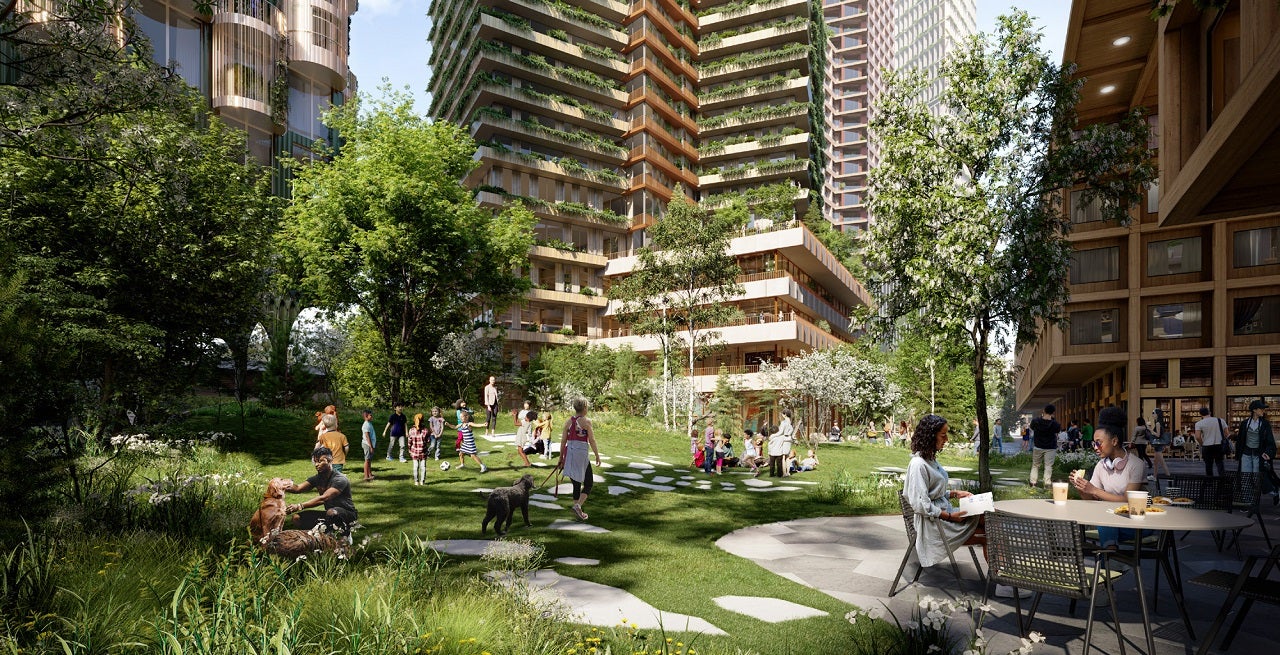
The Community Forest will be a network of green spaces spanning from Bonnycastle Street in the west to Parliament Street in the east
As noted at the beginning of this blog entry, resilience includes and extends beyond greenhouse gas emissions; it also considers a community’s ability to adapt to, and rebound from, extreme weather events. To reach this end, resilient communities focus on ecology; thrive in response to social and economic challenges; offer new parks, streets, and public spaces; reduce waste and water use; and apply Indigenous values, knowledge and experience through meaningful collaboration.
The design and operation of Quayside will deliver on this vision of resilience in the following ways:
Focusing on ecology: A network of 3.5 acres of robust accessible and biodiverse public spaces, including a 2-acre network of green spaces, dubbed the Community Forest.
Thriving in response to social and economic challenges: A Community Care Hub, offering programs and services to support ageing in place, recreation, and wellness for all residents; and more than 800 units of Affordable Rental Housing, more than half of which will be family-sized – two-bedroom and larger.
Offering new parks, streets, and public spaces: A 1-acre rooftop urban farm that provides all-season space for recreation, rest, and reflection.
Reducing waste and water use: Ensuring the elimination of single-use plastics in tenant agreements for retail and restaurant spaces.
Applying Indigenous values, knowledge and experience: Planning for the Seventh Generation, an approach that focuses on multi-generational impacts - extract resources only when necessary, using materials appropriately, reduce energy usage, use what Mother Nature provides - active technologies to produce energy and use rainwater.
A Harbinger of Things to Come
Quayside will spark new approaches to urban resilience and innovation in the 21st Century. Indeed, the lessons learned throughout the Quayside project will be instrumental to guiding the design and buildout of future waterfront communities like Villiers Island, a new island community to be enabled by the Ports Lands Flood Protection project. Like Quayside, Villiers Island has a mandate to deliver zero-carbon buildings (read more about the Villiers Island project here). Even more, it has the potential to become a worldwide precedent for green growth – a demonstration project that responds to contemporary challenges like climate change, economic inequality, and the decline of biodiversity. In this way, Quayside will make a real impact on people’s lives and its success will be measured by the improvements in the quality of life for those who live, work and visit there.
To learn more about Quayside’s impacts, stay tuned for future blog posts in this series.


